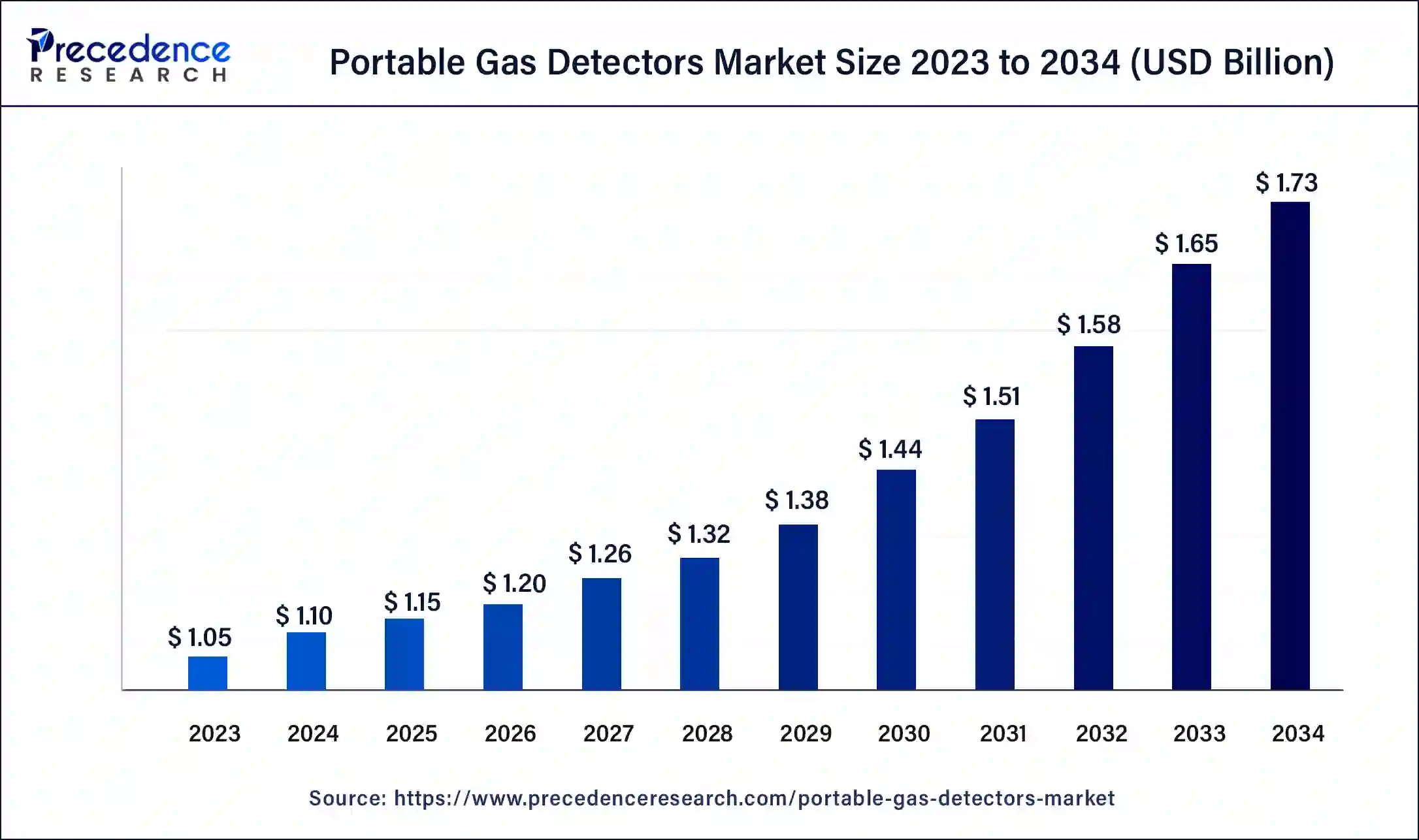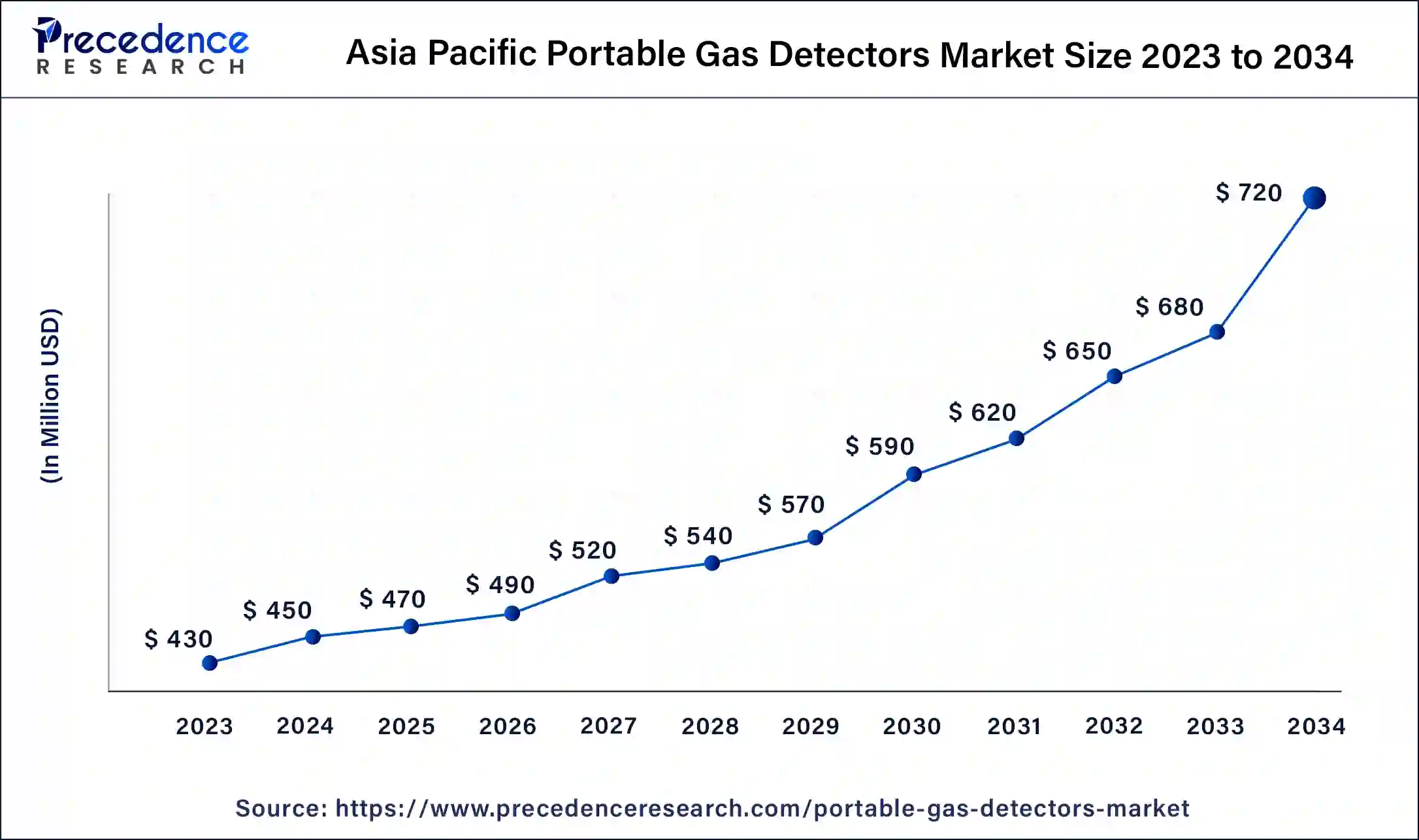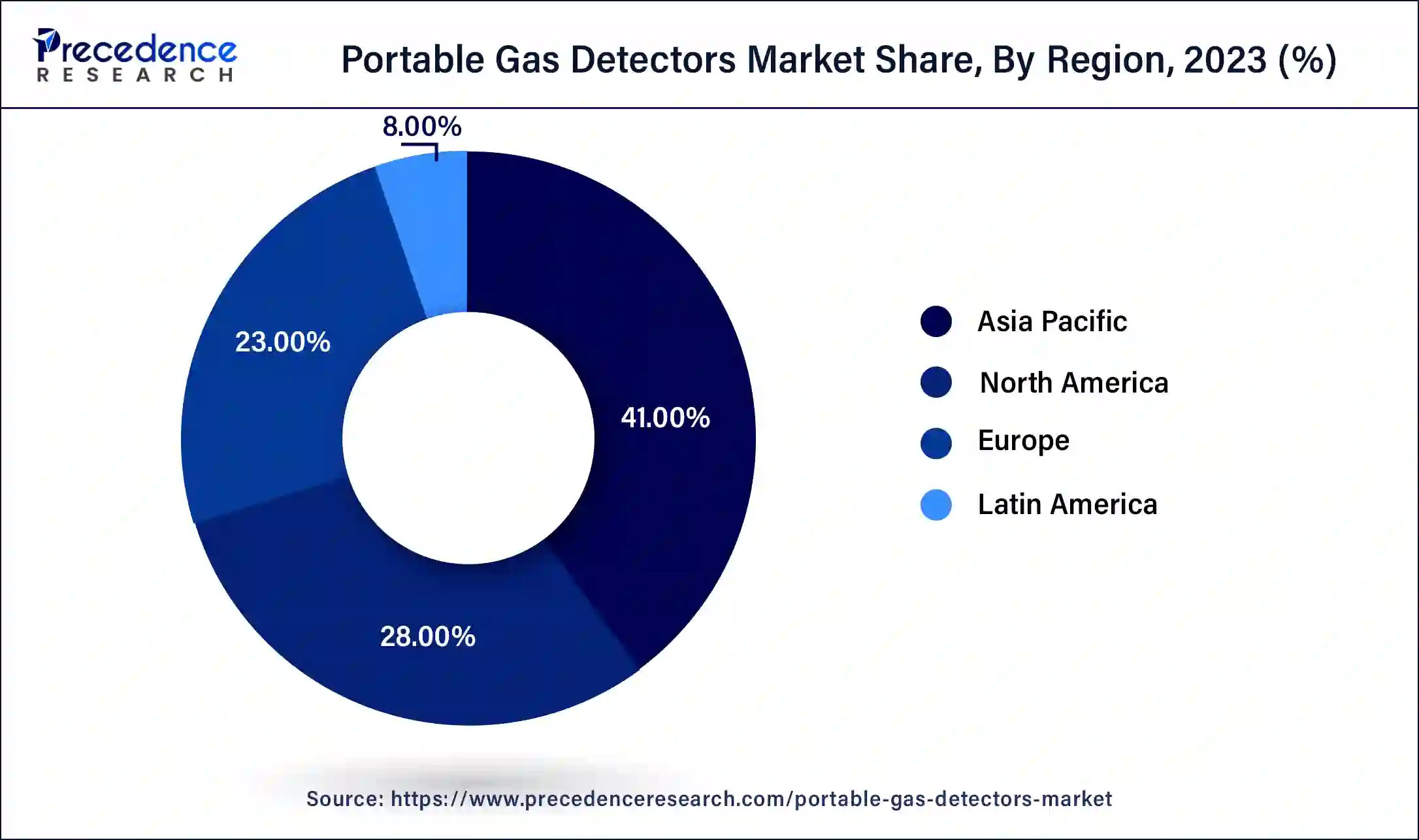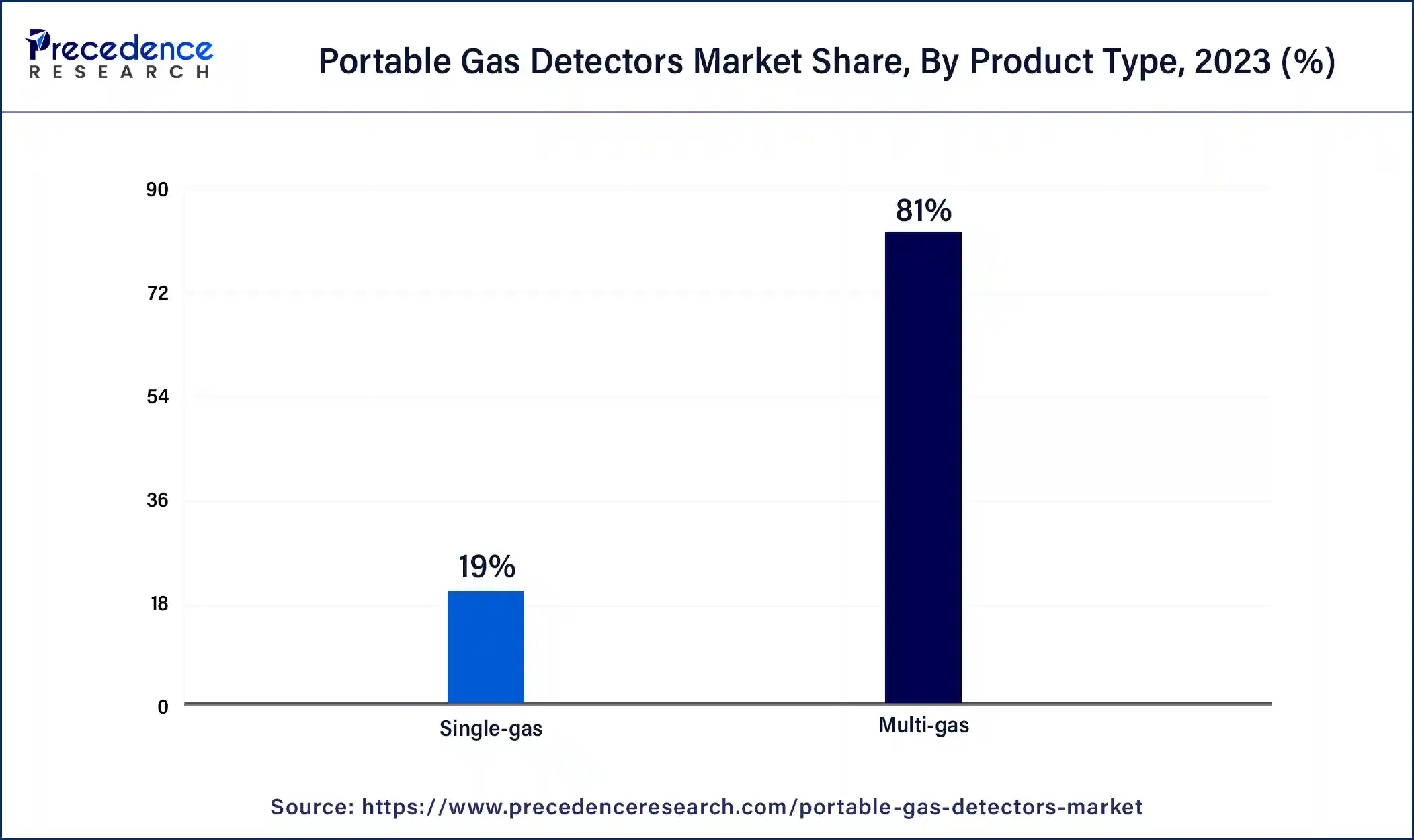The global portable gas detectors market size was USD 1.05 billion in 2023, estimated at USD 1.10 billion in 2024 and is expected to reach around USD 1.73 billion by 2034, expanding at a CAGR of 4.62% from 2024 to 2034.
The global portable gas detectors market size is worth around USD 1.10 billion in 2024 and is anticipated to reach around USD 1.73 billion by 2034, growing at a CAGR of 4.62% over the forecast period 2024 to 2034. increase in the e-commerce industry are key factors driving the growth of the portable gas detectors market.

The Asia Pacific portable gas detectors market size was valued at USD 430 million in 2023 and is expected to be worth around USD 720 million by 2034, at a CAGR of 4.79% from 2024 to 2034.

Asia Pacific dominated the portable gas detectors market in 2023. In the region, substantial investments in infrastructure and technology are driving the increased adoption of advanced gas detection solutions. Growing awareness of occupational health risks and the heightened demand for safer, more sustainable industrial operations are fueling the market for gas detection equipment.
China stands out as a major market for these devices within the Asia Pacific, with rising demand aimed at maintaining air quality, detecting hazardous gases, particularly in commercial buildings, and preventing critical incidents. This trend is expected to boost the region's gas detector market. Furthermore, Singapore has become a key hub for the petrochemical industry due to significant investments from leading global players and efforts to reduce carbon emissions.

North America is expected to witness the fastest growth in the portable gas detectors market over the forecast period. The region features a well-established industrial landscape spanning sectors such as oil & gas, chemicals, manufacturing, and mining, among others. These industries adhere to rigorous safety regulations and standards, which require the implementation of gas detection systems to ensure both worker safety and regulatory compliance. Hence, there is a steady and considerable demand for gas detectors within these fields. Additionally, North America hosts several prominent manufacturers and suppliers of gas detection equipment that utilize advanced technology and innovation to provide high-quality, reliable, and state-of-the-art solutions.
Region-wise global gas production statistics (2023)
| Region | 2023 Gas Production Change | Key Details |
| Global | +0.7% | Slight increase after stagnation in 2022 |
| The U.S. | +4.7% | Nearly matches 2010-2019 average growth |
| Middle East | +2.7% | Below historical average; Iran +1.3%, Saudi Arabia stable |
| Asia | +3.5% | China +6%, India +6%, Indonesia +2.1% |
| Africa | Stable | Algeria +8.3%, Egypt -11 |
| Latin America | Stable | Brazil +8.6% |
| Australia | +0.8% | Minimal increase |
Portable gas detection devices are essential for identifying hazards from gases that cannot be sensed by human detection, such as toxic gases, oxygen deficiency, and combustible gases or vapors. These portable detectors feature specialized sensors, including catalytic bead, electrochemical, photoionization, infrared, holographic, and ultrasonic types, each designed to monitor environmental changes. The advantages of the portable gas detectors market include the ability to cover a broad area, provide quick responses to environmental changes, and indicate the level of hazard present.
Impact of AI on the Portable Devices Industry
The portable gas detectors market is experiencing growth due to the rising demand for portable gas detectors that incorporate Internet of Things (IoT) and artificial intelligence (AI) technologies. These advancements are essential for making predictive maintenance, providing real-time data analysis, and delivering alerts to miners dispersed across various locations. The innovation focuses on developing innovative AI methods to address the critical social and industrial challenge of detecting and controlling gas leaks promptly by mitigating property damage and preventing loss of life in severe situations.
| Report Coverage | Details |
| Market Size by 2034 | USD 1.73 Billion |
| Market Size in 2023 | USD 1.05 Billion |
| Market Size in 2024 | USD 1.10 Billion |
| Market Growth Rate from 2024 to 2034 | CAGR of 4.62% |
| Largest Market | Asia Pacific |
| Base Year | 2023 |
| Forecast Period | 2024 to 2034 |
| Segments Covered | Product Type, Gas Type, End-user, Distribution Channel, and Region |
| Regions Covered | North America, Europe, Asia-Pacific, Latin America and Middle East & Africa |
Improved safety standards
The global enforcement of stricter industrial safety regulations is creating a substantial time for the portable gas detectors market. Enhanced safety standards and guidelines introduced by governments and international regulatory agencies aim to protect workers and environments from the risks associated with gas leaks. Hence, this regulatory shift is anticipated to drive a significant increase in demand for gas detection equipment and provide manufacturers and suppliers with considerable growth prospects to broaden their footprint.
Regional differences in regulations
Variations in regulations across regions can pose challenges for manufacturersof the portable gas detectors market, striving to develop a universal solution that meets all safety standards and criteria. Diverse regional safety regulations may limit the marketability of certain products. Additionally, integrating gas detection systems with existing industrial processes or safety infrastructure can present difficulties. Issues of compatibility might arise, which can potentially lead to increased costs or delays for organizations.
Implantation communication protocol for wireless integration of gas detectors
The advancement of standardized digital communication protocols, such as the highway addressable remote transducer (HART) protocol, offers enhanced reliability and safety in gas leakage detection. The HART protocol facilitates two-way communication and enables data exchange between gas detectors and control systems, which fixes accurate and real-time information for industries. Wireless integration allows for real-time monitoring of gas levels and environmental conditions and also provides immediate alerts and notifications to operators or personnel in case of gas leaks, anomalies, or hazardous events. This approach shortens installation time, reduces labor costs, lowers maintenance needs, and improves system reliability. These benefits collectively contribute to cost savings and productivity improvements throughout the system's lifecycle by creating significant opportunities for the portable gas detectors market.
The multi gas detector segment dominated the portable gas detectors market in 2023. Multi-gas meters are important for ensuring worker safety, adhering to regulations, detecting gas leaks early, and improving situational awareness. These devices provide a comprehensive overview of the work environment, which allows the identification of potential leaks before they escalate into hazardous or catastrophic situations. This capability is anticipated to drive growth in the segment.

The single gas detectors segment is expected to grow at the fastest rate in the portable gas detectors market over the forecast period. This is because single gas detectors specialize in monitoring one specific gas, such as Carbon Monoxide, Ammonia, Hydrogen Cyanide, or Sulfur Dioxide, among others. These detectors are typically more compact and lighter compared to multi-gas detectors, which makes them convenient to wear as part of a uniform or clip onto a belt. The benefits of single gas detectors, including their portability and ease of use, are driving growth in this segment throughout the projected period.
The flammable gas segment led the global portable gas detectors market in 2023. A flammable gas detector is designed to identify the presence of explosive or flammable gases based on their Lower Explosive Limit (LEL). It serves to detect leaks of combustible gases, including natural gas, butane, propane, hydrocarbons, solvents, and alcohol. The convenient use of flammable gas detectors is boosting the segment's growth.
The toxic gases segment is anticipated to grow at the fastest rate in the portable gas detectors market during the forecast period. Toxic gases are harmful when inhaled, causing adverse physiological effects. Carbon monoxide and hydrogen cyanide, two of the most frequently implicated toxic gases in inhalation injuries, are major contributors to smoke inhalation harm. While such inhalation is often accidental, these gases are also linked to deliberate harm, such as in cases of suicide attempts or capital punishment.
In 2023, the direct sale segment dominated the portable gas detectors market globally. Direct sales include transactions where a brand sells its products or services directly to the end-user, bypassing intermediaries or distributors. This approach provides a straightforward path to entrepreneurship and allows individuals to launch a business with minimal startup costs and without the need for prior experience.
The indirect sales segment is estimated to show the fastest growth in the portable gas detectors market over the projected period. Indirect sales involve a company leveraging third-party entities, such as affiliates, resellers, or distributors, to promote and sell its products. This method enables businesses to extend their market reach and increase sales without having to oversee each transaction directly.
The oil & gas segment led the portable gas detectors market in 2023. Gas leak detectors play a crucial role in the oil and gas sector, providing essential protection against hazardous gases like toxic, combustible, and deadly substances. Driven by numerous government initiatives that promote the use of these devices, the Oil & Gas industry is anticipated to become one of the leading adopters of gas detectors. As energy demand rises, the world is encountering challenges to ensure the secure supply of energy resources to fulfill the domestic needs of various economies.
The chemical & petrochemicals segment is projected to grow at the fastest rate in the portable gas detectors market during the forecast period. The petrochemical sector, which includes products derived from petroleum and natural gas such as synthetic rubber, yarn, polymers, plastics, and detergents, is a key component of the chemical industry. This wide industry encompasses various product manufacturing sectors that rely heavily on chemicals in their production processes.
Segments Covered in the Report
By Product Type
By Gas Type
By End-user
By Distribution Channel
By Geography
For inquiries regarding discounts, bulk purchases, or customization requests, please contact us at sales@precedenceresearch.com
No cookie-cutter, only authentic analysis – take the 1st step to become a Precedence Research client